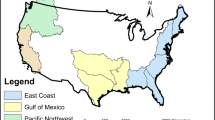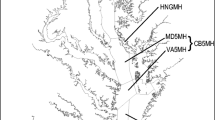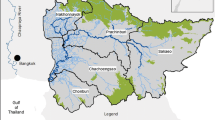Abstract
Nitrogen (N) loading to estuaries has become a major concern for coastal planners. As urban development on coastal watershed continues, estuaries and bays are becoming more eutrophic, and cascading effects are being felt at every trophic level. Managers and stakeholders need to have a suite of effective management tools that can be applied to coastal watersheds to minimize the effects of eutrophication. We applied an N loading model and an estuarine loading model to examine the effectiveness of a suite of potential management options that could be implemented in Waquoit Bay, Cape Cod, Massachusetts. This estuarine system is a case study in which we can explore the relative potential effectiveness of decreasing inputs from wastewater and fertilizer-derived N, diverting nitrogenous runoff from impervious surfaces, altering zoning ordinances, preserving forested tracts of land as well as freshwater and saltwater wetlands, harvesting macroalgae, dredging estuary channels, and exterminating waterfowl. From a combination of simulation results, assessment of the magnitude of loads from different sources, and through different land covers, and the additional consideration of feasibility we identified management options with high, intermediate, and low potential effectiveness. Improvement of septic system performance, use of zoning regulations, preservation of forested tracts and freshwater bodies, and conservation of salt marshes emerged as the most promising avenues to manage N loads in our system. Installation of wastewater treatment plants, controlling fertilizer use, and harvesting macroalgae would potentially have intermediate success. Diversion of runoff from impervious surfaces, dredging, and extermination of waterfowl show little promise at reducing N loads. These conclusions potentially set priorities for decision-makers charged with the management of Waquoit Bay. The same procedures applied to another watershed-estuary system with different land covers and different estuarine features may differ. Evaluation studies like this need to be done for any particular site, since the watershed-estuary coupling and the loads delivered to the receiving estuary could differ. The Waquoit Bay case study provides an example of a protocol that leads to identification of the most promising management options.
Similar content being viewed by others
Literature Cited
Aber, J. D., A. H. Magill, S. G. McNulty, R. D. Boone, K. J. Nadelhoffer, M. R. Downs, andR. Hallett. 1995. Forest biogeochemistry and primary production altered by nitrogen saturation.Water, Air, and Soil Pollution 85:1665–1670.
Aber, J. D., K. J. Nadelhoffer, P. Steudler, andJ. M. Mellillo. 1989. Nitrogen saturation in northern forest ecosystems.BioScience 39:378–386.
Albanese, B. andG. Matlack. 1998. Environmental auditing: Utilization of parking lots in Hattiesburg, Mississipp, USA, and impacts on local streams.Environmental Management 24:265–271.
Alexander, R. B., P. J. Johnes, E. W. Boyer, andR. A. Smith. 2002. A comparison of models for estimating the riverine export from large watersheds.Biogeochemistry 57:295–339.
Arnold, C. L. andC. J. Gibbons. 1996. Impervious surface coverage: The emergence of a key environmental indicator.Journal of the American Planning Association 62:243–258.
Bowen, J. L. andI. Valiela. 2001a. The ecological effects of urbanization of coastal watersheds: Historical increases in nitrogen loads and eutrophication of Waquoit Bay estuaries.Canadian Journal of Fisheries and Aquatic Sciences 18:1489–1500.
Bowen, J. L. andI. Valiela. 2001b. Historical changes in atmospheric nitrogen deposition to Cape Cod, Massachusetts.Atmospheric Environment 35:1039–1051.
Boynton, W. R., J. H. Garber, R. Summers, andW. M. Kemp. 1995. Inputs, transformations, and transport of nitrogen and phosphorus in Chesapeake Bay and selected tributaries.Estuaries 18:285–314.
Brawley, J. W., G. Collins, J. N. Kremer, C.-H. Sham, andI. Valiela. 2000. A time-dependent model of nitrogen loading to estuaries from coastal watersheds.Journal of Environmental Quality 29:1448–1461.
Bricker, S. B., C. G. Clement, D. E. Pirhala, S. P. Orland, andD. G. G. Farrow. 1999. National Estuarine Eutrophication Assessment: Effects of Nutrient Enrichment in the Nation’s Estuaries. NOAA, Silver Spring, Maryland.
Cantor, L. W. andR. C. Knox. 1985. Septic Tank System Effects on Ground Water Quality. Lewis Publishers, Inc., Chelsea, Michigan.
Caraco, N. F. andJ. J. Cole. 1999. Human impact on nitrate export: An analysis using major world rivers.Ambio 28:167–170.
Cohen, J. E., C. Small, A. Mellinger, J. Gallup, andJ. D. Sachs. 1997. Estimates of coastal populations.Science 278:1211.
Cole, J. J., B. L. Peierls, N. F. Caraco, andM. L. Pace. 1993. Nitrogen loading of rivers as a human-driven process, p. 138–154.In M. J. McDonnell and S. T. A. Pickett (eds.), Humans as Components of Ecosystems: The Ecology of Subtle Human Effects and Populated Areas. Springer-Verlag, New York.
Conley, D. J., S. Markager, J. Andersen, T. Ellermann, andL. M. Svendsen. 2002. Coastal eutrophication and the Danish National Aquatic Monitoring and Assessment Program.Estuaries 25:848–861.
Corredor, J. E. andJ. M. Morel. 1984. Nitrate depuration of secondary sewage effluents in mangrove sediments.Estuaries 17:295–300.
Culliton, T. J., C. M. Blackwell, D. G. Remer, T. R. Goodspeed, andM. A. Warren. 1989. Selected characteristics in coastal states, 1980–2000. National Oceanic Atmospheric Administration (NOAA), Strategic Assessment Branch, Washington, D.C.
Dahl, T. E. andE. Johnson. 1991. Status and trends of wetlands in the coterminous US, mid 1970s to mid 1980s. U.S. Department of Fish and Wildlife Service, Washington, D.C.
Dettmann, E. 2001. Effects of water residence time on annual export and denitrification of nitrogen in estuaries: A model analysis.Estuaries 24:481–490.
Duarte, C. M. 1995. Submerged aquatic vegetation in relation to different nutrient regimes.Ophelia 41:87–112.
Environmental Protection Agency (EPA). 2000. Wastewater Technology Fact Sheet: Package plants. EPA 832-F-00-016. Otfice of Water, Washington, D.C.
Gaines, A. G. 1986. Lagoon Pond Study: An assessment of environmental issues and observations on the estuarine system. Final report for the Town of Oak Bluffs. Woods Hole Oceanographic Institution, Woods Hole, Massachusetts.
Galloway, J. N. 1998. The global nitrogen cycle: Changes and consequences.Environmental Pollution 102:15–24.
Group of Experts on the Scientific Aspects of Marine Pollution (GESAMP). 1990. State of the Marine Environment. Reports and studies No. 39. Joint Group of Experts on the Scientific Aspects of Marine Pollution, United Nations Environment Programme. Nairobi, Kenya.
Goldberg, E. D. 1995. Emerging problems in the coastal zone for the twenty-first century.Marine Pollution Bulletin 31:152–158.
Greening, H. andC. Elfring. 2002. Local, state, regional, and federal roles in coastal nutrient management.Estuaries 25: 838–847.
Hauxwell, J., J. Cebrian, C. Furlong, andI. Valiela. 2001. Macroalgal canopies contribute to eelgrass (Zostera marina) decline in temperate estuarine ecosystems.Ecology 82:1007–1022.
Hersh, D. A. 1996. Abundance and Distribution of Intertidal and Subtidal Macrophytes in Cape Cod: The Role of Nutrient Supply and other Controls. Ph.D. Dissertation, Boston University, Boston, Massachusetts.
Heufelder, G. andS. Rask. 2001. The second compendium of information on alternative onsite septic system technology in Massachusetts.Environment Cape Cod 4:1–69.
Hinga, K. R., A. A. Keller, andC. A. Oviatt. 1991. Atmospher ic deposition and nitrogen inputs to coastal waters.Ambio 20: 256–260.
Howes, B. L. andJ. M. Teal. 1995. Nutrient budget of a Massachusetts cranberry bog and relationships to coastal eutrophication.Environment Science and Technology 29:960–974.
Isaji, T. andM. L. Spaulding. 1984. A model of the tidally induced residual circulation in the Gulf of Maine, and Georges Bank.Journal of Physical Oceanography 14:1119–1126.
Jaworski, N. A., R. W. Howarth, andL. J. Hetling. 1997. Atmospheric deposition of nitrogen oxides onto the landscape contributes to coastal eutrophication in the northeast United States.Environmental Science and Technology 31:1995–2004.
Johnes, P. J. 1996. Evaluation and management of the impact of land use changes on the nitrogen and phosphorus load delivered to surface waters: The export coefficient modeling approach.Journal of Hydrology 183:323–349.
Johnston, C. A. 1991. Sediment and nutrient retention by freshwater wetlands: Effects on surface water quality.Critical Reviews in Environmental Control 21:491–565.
Jordan, T. E., D. L. Correll andD. E. Weller. 1997. Effects of agriculture on discharges of nutrients from coastal plain watersheds of Chesapeake Bay.Journal of Environmental Quality 26:836–848.
Jordan, T. E. andD. E. Weller. 1996. Human contributions to total nitrogen flux.BioScience 46:655–664.
Lee, V. andS. Olsen. 1985. Eutrophication and management initiatives for the control of nutrient inputs to Rhode Island coastal lagoons.Estuaries 8:191–202.
Levins, R. 1966. The strategy of model building in population biology.American Scientist 54:421–431.
Mallin, M. A., L. B. Cahoon, R. P. Lowe, J. F. Merritt, R. K. Sizemore, andK. E. Williams. 2000. Restoration of shellfishing waters in a tidal creek following dredging.Journal of Coastal Research 16:40–47.
McColl J. G. andJ. Burger. 1976. The chemical input by a colony of Franklin’s Gulls nesting in cattails.American Midland Naturalist 96:270–280.
Monsen, N. E., J. E. Cloern, L. V. Lucas, andS. G. Monismith. 2002. The use of flushing time, residence, time and age as transport time scales.Limnology and Oceanography 47:1545–1553.
Nadelhoffer, K. J., M. R. Downs, B. Fry, J. A. Aber, A. H. Magill, andJ. M. Mellilo. 1995. The fate of15N labeled nitrate additions to a northern hardwood forest in eastern Maine.Oecologia 103:292–301.
Nicholls, R. J. andC. Small. 2002. Improved estimates of coastal population and exposure to hazards released.EOS 83: 301.
Nixon, S. W. 1982. The ecology of New England high salt marshes: A community profile. FWS/OBS-81/55. Fish and Wildlife Service, U.S. Department of the Interior, Washington, D.C.
Nixon, S.W. 1995. Coastal marine eutrophication: A definition, social causes, and future concerns.Ophelia 41:199–219.
Peckol, P., B. Demeo-Anderson, J. Anderson, I. Valiela, M. Maldonado, andJ. Yates. 1994. Growth nutrient uptake capacities and tissue constituents of the macroalgaeCladophora vagabunda andGracilaria tikvahiae related to site specific nitrogen loads.Marine Biology 121:175–185.
Portnoy, J. W. 1990. Gulf contributions of phosphorus and nitrogen to a Cape Cod kettle pond.Hydrobiologia 202:61–69.
Rask, S. 1998. Alternative septic systems: Results of monitoring reported to Massachusetts DEP as of March, 1998.Environment Cape Cod 1:50–59.
Sand-Jensen, K. andJ. Borum. 1991. Interactions among phytoplankton, periphyton, and macrophytes in temperate freshwaters and estuaries.Aquatic Botany 41:137–175.
Smil, V. 1997. Global population and the nitrogen cycle.Scientific American 277:76–81.
Smil, V. 1999. Nitrogen in crop production: An account of global flows.Global Biogeochemical Cycles 13:647–662.
Stokes, J. C. 2000. General information on wastewater and alternative onsite sewage systems. Ad Hoc Committee on Alternative Septic Systems. New Jersey Pinelands Commission, New Lisbon, New jersey. <http://www.state.nj.us/pinelands./428rept.htm>
Valiela, I. andJ. L. Bowen. 2002. Nitrogen sources to watersheds and estuaries: Role of land cover mosaics and losses within watersheds.Environmental Pollution 118:239–248.
Valiela, I. andJ. L. Bowen. 2003. Recent shifts in winter distributions of birds: Effects of global warming and local habitat change.Ambio 32:476–480.
Valiela, I., J. L. Bowen, andK. D. Kroeger. 2002. Assessment of models for estimation of land-derived nitrogen loads to shallow estuaries.Applied Geochemistry 17:935–953.
Valiela, I., J. L. Bowen, andJ. K. York. 2001. Mangrove forests: One of the world’s most threatened major tropical environments.BioScience 51:807–815.
Valiela, I. andM. L. Cole. 2002. Comparative evidence that salt marshes and mangroves protect seagrass meadows from land-derived nitrogen loads.Ecosystems 5:92–102.
Valiela, I., G. Collins, J. Kremer, K. Lajtha, M. Geist, B. Seely, J. Brawley, andC.-H. Sham. 1997b. Nitrogen Loading from coastal watersheds to receiving estuaries: New method and application.Ecological Applications 7:358–380.
Valiela, I. andJ. Costa. 1988. Eutrophication of Buttermilk Bay, a Cape Cod coastal embayment: Concentrations of nutrients and watershed nutrient budgets.Environmental Management 12:539–553.
Valiela, I., K. Foreman, M. LaMontagne, D. Hersh, J. Costa, P. Peckol, B. Demeo-Anderson, C. D’Avanzo, M. Babione, C.-H. Sham, J. Brawley, andK. Lajtha. 1992. Couplings of watersheds and coastal waters: Sources and consequences of nutrient enrichment in Waquoit Bay, Massachusetts.Estuaries 15:443–457.
Valiela, I., M. Geist, J. McClelland, andG. Tomasky. 2000a. Nitrogen loading from watersheds to estuaries: Verification of the Waquoit Bay nitrogen loading model.Biogeochemistry 49: 277–293.
Valiela, I., S. Mazzilli, J. L. Bowen, K. D. Kroeger, M. L. Cole, G. Tomasky, and T. Isaji. 2004. ELM an estuarine nitrogen loading model: Formulation, verification of predicted concentrations of dissolved inorganic nitrogen.Water, Air, and Soil Pollution. In press.
Valiela, I., J. McClelland, J. Hauxwell, P. J. Behr, D. Hersh, andK. Foreman. 1997a. Macroalgal blooms in shallow estuaries: Controls and ecophysiological and ecosystem consequences.Limnology and Oceanography 42:1105–1118.
Valiela, I. andJ. M. Teal. 1976. The nitrogen budget of a salt marsh ecosystem.Nature 280:652–656.
Valiela, I., G. Tomasky, J. Hauxwell, M. L. Cole, J. Cebrian, andK. D. Kroeger. 2000b. Operationalizing sustainability: Management and risk assessment of land-derived nitrogen loads to estuaries.Ecological Applications 10:1006–1023.
Vitousek, P. M., J. D. Aber, R. W. Howarth, G. E. Likens, P. A. Matson, D. W. Schlinder, W. H. Schlesinger, andD. G. Tilman. 1997c. Human alterations of the global nitrogen cycle: Sources and consequences.Ecological Applications 7:737–750.
Westgate, E. J., K. D. Kroeger, W. J. Pabich, andI. Valiela. 2000. Fate of anthropogenic nitrogen in a nearshore Cape Cod aquifer.Biological Bulletin 199:221–223.
Sources of Unpublished Materials
Brawley, J. Unpublished data. Coastal Resource, and Environmental Management, Batelle, 397 Washington Street, Duxbury, Massachusetts 02332.
Deubert, K. H. Unpublished data. Impact of the cranberry industry on the quality of groundwater in the Cape Cod area. Completion Report FY-74-6. Water Resources Research Center, University of Massachusetts at Amherst Publication #42.1 State Bog Road, East Wareham, Massachusetts 02538.
Eichner, E. M. andT. C. Cambareri. 1992. Nitrogen Loading. Cape Cod Commission Technical Bulletin 91-001. Cape Cod Commission, 3225 Main Street, Barnstable, Massachusetts 02630.
Piluk, R. J. and E. C. Peters. Unpublished data. Small recirculating sand filters for individual homes. Anne Arundel County Health Department, Annapolis, Maryland. <http:// plymouth.ces.state.nc.us/septic/95piluk.html>
Stieve, E. Unpublished manuscript. Ecosystems Center, Marine Biological Laboratory, Woods Hole, Massachusetts 02543.
U.S. Census Bureau. Unpublished data. <www.census.gov>
Author information
Authors and Affiliations
Corresponding author
Rights and permissions
About this article
Cite this article
Bowen, J.L., Valiela, I. Nitrogen loads to estuaries: Using loading models to assess the effectiveness of management options to restore estuarine water quality. Estuaries 27, 482–500 (2004). https://doi.org/10.1007/BF02803540
Received:
Revised:
Accepted:
Issue Date:
DOI: https://doi.org/10.1007/BF02803540




